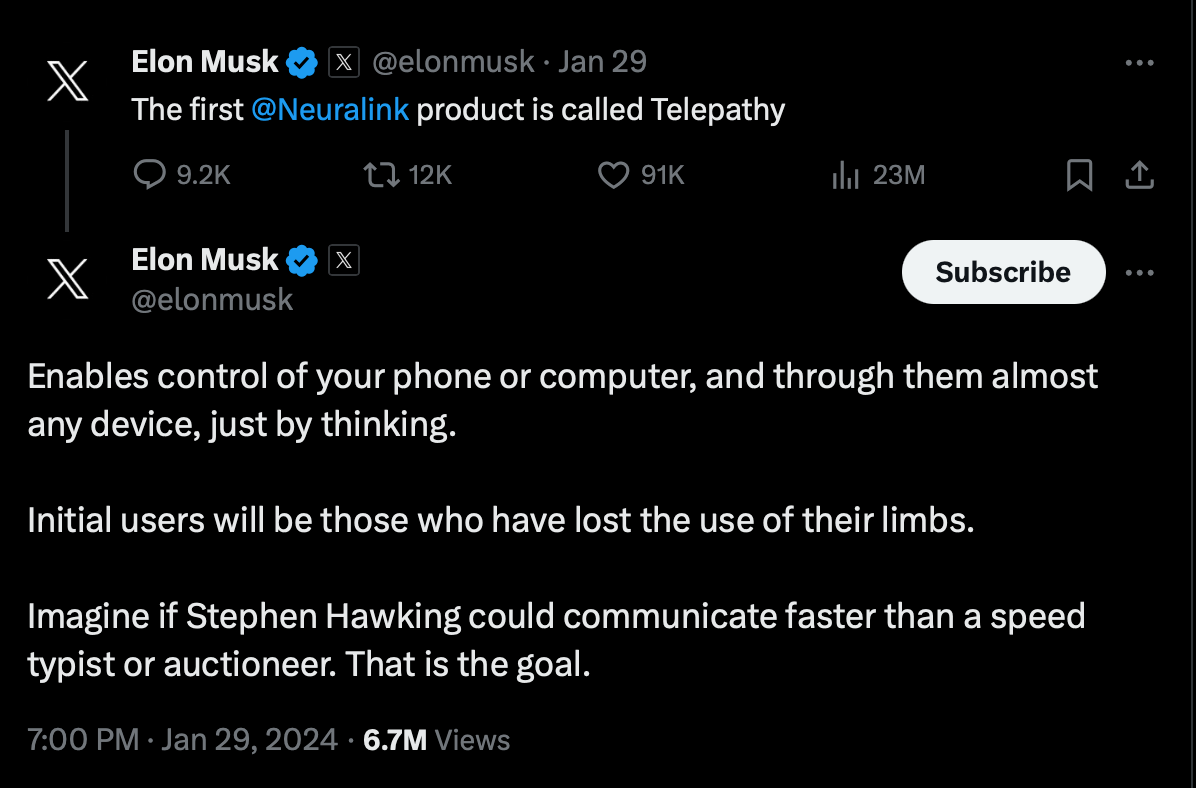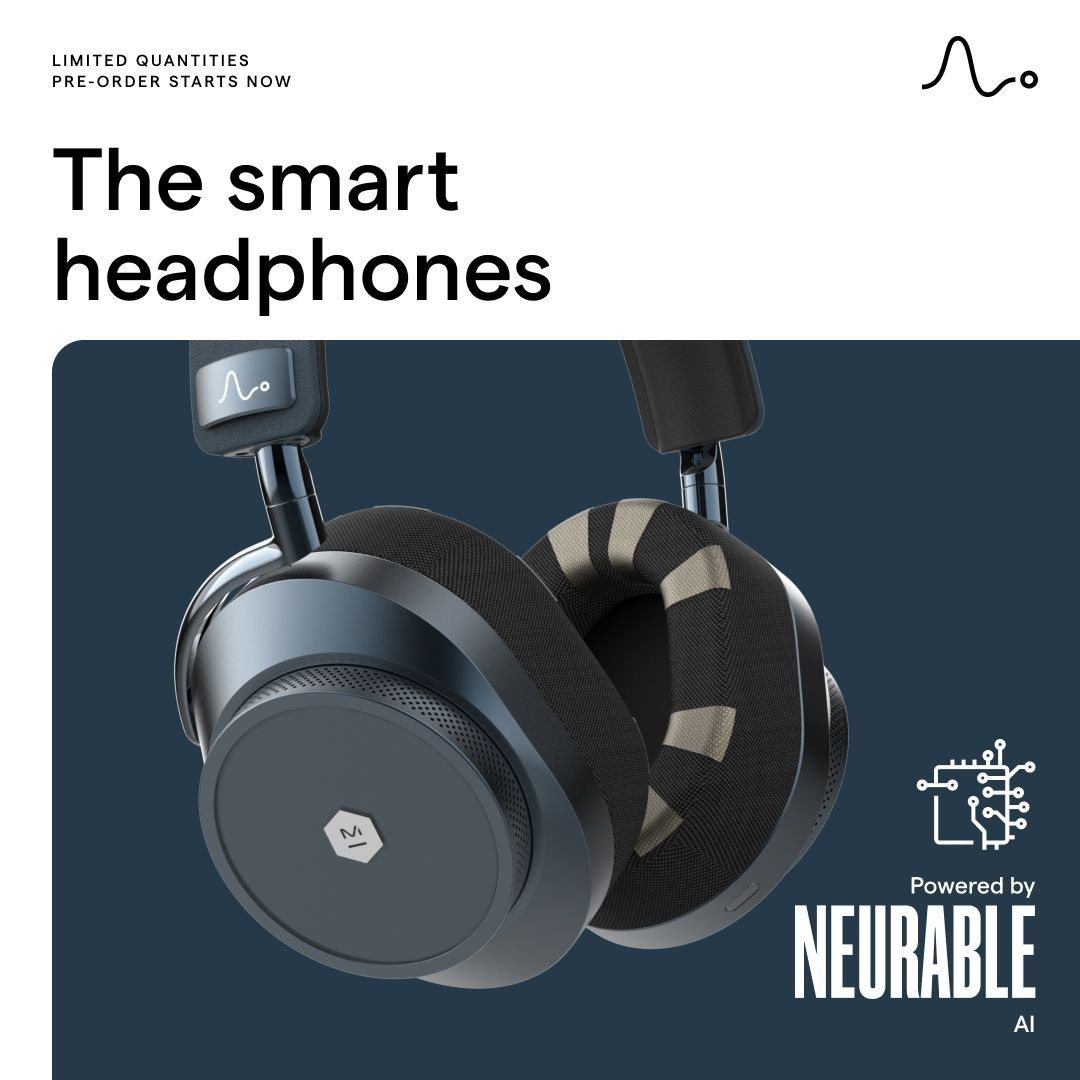The Deload explores my curiosities and experiments across AI, finance, and philosophy. If you haven’t subscribed, join nearly 2,000 readers:
Disclaimer. The Deload is a collection of my personal thoughts and ideas. My views here do not constitute investment advice. Content on the site is for educational purposes. The site does not represent the views of Deepwater Asset Management. I may reference companies in which Deepwater has an investment. See Deepwater’s full disclosures here.
Additionally, any Intelligent Alpha strategies referred to in writings on The Deload represent strategies tracked as indexes or private test portfolios that are not investable in either case. References to these strategies is for educational purposes as I explore how AI acts as an investor.
Brain Tech Breakthroughs
Big news in the brain computer interface (BCI) world: Elon Musk’s Neuralink announced it implanted its device in a first human patient. Musk detailed early goals for Neuralink on X:
The Neuralink news is an exciting advance for BCI technology, and there are exciting developments in other parts of BCI too.
Neurable, a portfolio company of Deepwater, has spent the last decade developing non-invasive BCI technology. The company is working on some of the same features on Neuralink’s roadmap minus the necessity of the implant. Neurable’s mission is to make neurotechnology accessible, and that means avoiding invasive surgeries that hinder widespread adoption.
Over the past decade, Neurable’s technology has evolved from a medical sensor cap that required gel for the electrodes to work down to over-the-ear headphones. That’s a big improvement to accessibility. This spring, Neurable is bringing its advancements in BCI to a consumer audience. The company is launching the MW75 Neuro headphones in partnership with Master & Dynamic. Pre-orders are available now.
I spoke with Neurable CEO and founder Ramses Alcaide about the MW75 Neuro launch on the latest Deload Podcast. We also spoke about how BCI can help enhance focus and performance in the near term, the differences between invasive and non-invasive BCI, and the opportunities for BCI to improve AI and other emerging technologies.
Here are my notes from our conversation.
The Apple Watch for Your Brain
Ramses described Neurable-powered devices like the MW75 Neuro as an Apple Watch for the brain. It’s one of the first practical devices to help you track brain data, the most important organ we aren’t already tracking.
Like the early Apple Watch focused on physical fitness, the MW75 Neuro headphones are built to track mental focus and performance. Neurable’s technology will suggest when to take work breaks and tell you when you’re primed to do deep work vs administrative work. Beyond early use cases, the company has an 18-month roadmap of additional features including control of music and customized focus playlists amongst other things. Also, I suspect the eventual opening of the Neurable platform to third-party developers will bring maximum creativity for novel breakthrough use cases of non-invasive BCI, just as we saw with the App Store for iPhone and Watch.
Invasive vs Non-invasive BCI
Invasive BCI has incredible potential to restore motion to the disabled among other use cases; however, the intensity of implantation inherently limits the potential market. Ramses used the analogy of a hip replacement to categorize invasive BCI. If your hip is non functional, you’d submit to invasive surgery with a long recovery to regain function via replacement. If your hip works fine but a bionic replacement is 10x better, that’s a tougher decision.
Is a 10x improvement to a functional hip worth the surgery? How do you even contextualize a 10x improvement? Perhaps some athletes or others might be willing to use implants for recreation, but the general populace won’t.
That’s where the non-invasive approach enters. There are many things that non-invasive BCI can do that we may mistakenly ascribe to more invasive approaches. For example, intelligent sound control and changes in tone driven by Neurable-powered headphones might be able to address many cases of hearing impairment. Non-invasive BCI can also potentially address communication via text, one of the use cases for Neuralink.
I use this example a lot, but we’re on the iPhone 1 of non-invasive BCI. It’s a profound new technology, and it’s going to change rapidly. Imagine the iPhone X version. It will make current iterations of BCI, invasive and non, seem arcane. The evolution of technology will bring us persistently improving benefits in BCI, just as it always does.
BCI + AI
My favorite use case for Neurable is integrating it with digital assistants to inform the assistant when it makes a mistake based on our brain activity. Ramses uses the example of asking Siri about a toy Yoda from Star Wars and Siri thinking you were talking about Toyota cars. With Neurable’s software, Siri could identify a change in your brain waves indicating that you think it’s giving you an incorrect answer. Instead of you having to stop the AI and giving it additional instruction, the understanding of your brain signal would inform the AI to stop automatically and try again.
Many novel technologies lack killer use cases, but that’s not the case for BCI. It’s a useful tool now for mental fitness and performance, and it will only become more powerful as Neurable continues to show us what’s possible with BCI in the mass market.
If you’re interested in learning even more about how Neurable sees the future, check out Ramses’ deep dive presentation:
Podcast Timestamps
1:00 Neurable’s mission: Make neurotechnology accessible
3:00 MW75 Neuro headset launch
6:00 Neurable is an Apple Watch for the brain/what Neurable can do for you
11:30 How Neurable and BCIs will combine with AI
20:00 Comparing non-invasive BCI like Neurable to invasive BCI like Neuralink
26:00 What Ramses is paying attention to in BCI in 2024
Disclaimer: My views here do not constitute investment advice. They are for educational purposes only. My firm, Deepwater Asset Management, may hold positions in securities I write about. See our full disclaimer.
Intelligent Alpha Mid Week Update
I wonder if Neurable could make humans better investors?
Maybe a BCI could tell me when I’m about to do something stupid — chase a stock I shouldn’t, or not chase a stock that I should. My brain activity must know when I’m acting counter to everything I’ve learned about investing. Perhaps another experiment for the future…
Setting aside BCIs, it’s the avoidance of human mistakes that makes generative AI such a great investor. As I wrote last week, AI is bound to be a better investor than humans simply because it isn’t human. AI doesn’t feel the pressure of being down, the euphoria of being up, or the stupidity of dogmatic bullish or bearish bias.
Given AI’s advantage of not being human, we shouldn’t be surprised that Intelligent Alpha continues to perform well vs benchmarks since inception. Despite the market volatility early this week, Intelligent Alpha has sustained leads vs benchmarks and in some cases even expanded them.
Just Ramses described the amazing benefits that non-invasive BCIs can bring vs invasive approaches, portfolios managed by AI can bring amazing benefits without the complexity of human management. You just have to trust the AI. The future of investing is intelligent.












